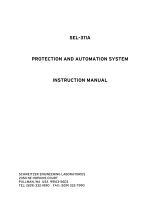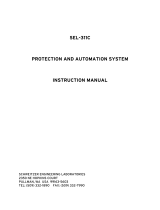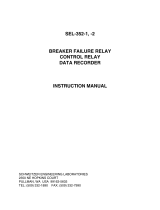Page is loading ...

1
For Additional Technical Assistance Call +1.509.332.1890
Express Installation Guide
SEL-751A Feeder Protection Relay
Package Contents
Panel Cutout Template Manual CD & ACSELERATOR®
QuickSet™ Software CD
No. 8-32 Mounting Screws,
Gasket, & Serial Port Cover
Configurable Label Kit
(if equipped)
Label Removal Tool
Blank Pushbutton LED Label
198–0424RIGHT
UP
Blank Target LED Label
198-0424LEFT UP
www . ElectricalPartManuals . com

2
Typical Connections
RX
TX
+
—
+
—
+
—
+
—
+
—
+
—
+
—
+
—
+
—
+
—
5 4 3 2 1
9 8 7 6
5 4 3 2 1
9 8 7 6
Ethernet
Port 4 DeviceNet
(Optional)
V–
CAN_L
SHIELD
CAN_H
V+
A
C
B
52
Open-Delta Potential and Residual Ground CT Connections
Typical Wiring
Prot.
Alarm
OUT101
OUT102
OUT103
A01 A02 A03 A04 A05 A06 A07 A08 A09 A10 A11 A12
IRIG-B
-/N+/H
IA IB IC IN
Z07Z06
CURRENT INPUTS
VOLTAGE INPUTS (Optional)
Z05Z04Z03Z02Z01E04E03E02E01
NVCVBVA
Z08
TX+
TX–
RX+
RX–
SHIELD
(Optional)
Port 4A EIA-485
IRIG-B Time Source
≤ 500 m
FO Cable**
1–12 RTDs
Optional Input Output Cards
10 RTDs
4 Digital Inputs / 4 Digital Outputs
3 Digital Inputs / 4 Digital Outputs / 1 Analog Output
8 Analog Inputs
4 Analog Inputs / 4 Analog Outputs
Front
Port 3
TCCC
Feeder
8 Digital Inputs
(+)
(–) 52B 52A
Close
Circuit
Trip
Circuit
IN101 IN102
CONTROL INPUTS
INPUT POWER
OUTPUT CONTACTS
SEL-751A
Feeder Protection Relay
A diagram for a four-wire wye
connection is also available in the
instruction manual.
** SEL Fiber Optic Cables
240-1506 — 1 m (3.3 ft) ST/ST
240-1507 — 5 m (16.4 ft) ST/ST
240-1508 — 15 m (49.2 ft) ST/ST
Other lengths available by request
Power Supply
110–230 Vac
24–48 Vdc
110–250 Vdc
(Optional
485)
(Optional)
(Optional)
Fiber-Optic
Input
Fiber-Optic
Output
SEL-2600 Series
External
RTD Module
(Optional)
www . ElectricalPartManuals . com

3
You should mount the SEL-751A in a sheltered indoor environment (a building or an enclosed cabinet) that does not exceed
the temperature rating of –40°C to +85°C. For mounting consideration, the relay dimensions are shown below.
Retrofitting
Step 1. Remove old relay.
Step 2. Insert retrofitting plate and fasten (several retrofit plates are available—see http://www.selinc.com/sel-751a.htm).
Step 3. Place mounting gasket around relay and insert unit into retrofitting plate.
Step 4. Fasten relay to mounting plate with included screws.
Rack Mounting
New Control Center
Step 1. Place the enclosed Panel Cutout over desired
mounting location and trace.
Step 2. Make smooth cut around cutout.
Step 3. Place mounting gasket around relay and insert unit
into hole. Use SEL-751A appearance bezel if cut is
not as accurate as desired. (Photo in Step 3 displays
optional appearance bezel.)
Step 4. Fasten relay to mounting plate with included
screws.
Step 1
Step 2
Step 3
Step 4
Step 1
Step 2
Step 3
Step 4
www . ElectricalPartManuals . com

4
Shown for the SEL-751A with Ethernet, Fiber Optic, IRIG-B, EIA-232, 4 DO/3 DI/1 AO Option, 8 DI Option, and Voltage
Option. Refer to the SEL-751A manual for additional details and other options.
Wire sizes for connections are dictated by the terminal blocks and expected load currents. You may use the following table
as a guide in selecting wire sizes:
Connections
Connection Type Minimum Wire Size Maximum Wire Size
Grounding (Earthing) Connection 18 AWG (0.8 mm2) 14 AWG (2.5 mm2)
Current Connection 16 AWG (1.5 mm2)12 AWG (4 mm
2)
Potential (Voltage) Connection 18 AWG (0.8 mm2) 14 AWG (2.5 mm2)
Contact I/O 18 AWG (0.8 mm2) 14 AWG (2.5 mm2)
Other Connection 18 AWG (0.8 mm2) 14 AWG (2.5 mm2)
Card Slot A: Power Supply Card With 2 DI/3 DO
Step 1. Connect ground terminal GND to a rack frame or switchgear ground for proper safety and performance.
Step 2. Connect appropriate power supply to terminal 01 (+/H) and terminal 02 (–/N). Note that power terminals are isolated
from chassis ground.
Step 3. Connect up to 2 digital inputs, per application requirements, to optoisolated inputs IN101 (terminals 10, 11) and
IN102 (terminals 11, 12).
Step 4. Connect the 3 output contacts, per application requirements, to OUT101 (terminals 03, 04), OUT102 (terminals 05,
06), and OUT103 (terminals 07, 08, 09).
Card Slot B: Main Board With Ethernet, Fiber Optic, IRIG-B, and EIA-232
Step 1. Connect communications devices as required to front DB-9 serial Port F (EIA-232), rear Port 3 (EIA-232),
10/100BASE-T Ethernet (RJ-45 connector) Port 1 and fiber-optic (ST® connector) serial Port 2.
Step 2. Connect IRIG-B time-code input to terminals 01 (+) and 02 (–).
Card Slot C: 3 Digital Inputs, 4 Digital Outputs, 1 Analog Output Card (3 DI/4 DO/1 AO)
Step 1. Connect additional digital inputs (IN_01, IN_02, IN_03) and outputs (OUT_01, OUT_02, OUT_03, OUT_04), if
required by application, using the connection diagram.
Step 2. Connect the analog (transducer) output AO_01 using terminals 09 and 10.
+5 Vdc
RXD
+IRIG–B
TXD
GND
5
–IRIG–B
RTS
GND
PORT 3
E IA–232
IRIG–B
PORT 2
FIBER OPT I C
TX
RX
1
2
4
3
6
8CTS
7
9
02
PORT 1
ETHERNET
01
+
—
10/100BASE–T
www . ElectricalPartManuals . com

5
Card Slot D: 8 Digital Inputs Card (8 DI)
Connect up to 8 digital inputs per application requirements to inputs IN_01 (terminals 01 and 02), IN_02 (terminals 03 and
04), . . ., IN_08 (terminals 15 and 16).
Card Slot E: Voltage Inputs Card
Connect 4-wire wye-connected PTs or open-delta connected PTs as shown in the typical connections diagram. For other PT
connection options refer to Section 2 of the SEL-751A manual.
Card Slot Z: Current Inputs Card
Connect phase current and neutral current inputs as shown in the typical connections diagram.
Step 1. Connect Phase A, Phase B, Phase C current inputs to terminals 01, 02; terminals 03, 04; and terminals 05, 06,
respectively, following the convention shown in the typical connections diagram.
Step 2. Connect neutral current IN inputs to terminals 07, 08.
Refer to Section 2 of the SEL-751A manual for additional details and other connection options.
www . ElectricalPartManuals . com

6
This section of the Express Installation Guide provides step-by-step instructions for a possible application of the SEL-751A
Feeder Protection Relay. For more information on the setting procedures, please refer to the SEL-751A instruction manual, or
contact your local SEL representative. For more information on relay setting using a PC configuration, please refer to Section 3
of the SEL-751A instruction manual.
The SEL-751A can be used to enable and disable Arc Flash Hazard Energy (AFHE) reducing protection. The AFHE reducing
protection enables a phase overcurrent element that is set sensitive enough to provide instantaneous tripping for phase fault on
downstream energized equipment. When properly implemented, this protection may, reduce incident energy exposure.
The SEL-751A relay is equipped with four levels of phase instantaneous overcurrent elements (50P1, 50P2, etc.) that may be set
and temporarily activated with a front panel pushbutton, to provide enhanced (faster and/or more sensitive) protection while ener-
gized work is being done on downstream equipment. It should be noted that activating this protection scheme might result in loss
of device coordination.
This example will use setting 50P1P for the AFHE protection.
Step 1. Connect to the SEL-751A Feeder Protection Relay via ACSELERATOR®
QuickSet™ SEL-5030 Software.
a. Connect the relay to a PC using a SEL-C234A serial or SEL-C662 USB
cable.
b. Apply power to the relay.
c. Start the ACSELERATOR QuickSet software program and establish
communication with relay.
d. Click on the Read Settings From Device icon to download the current
settings from the relay.
e. Save the downloaded setting file into your ACSELERATOR QuickSet
database.
Step 2. Edit the ACSELERATOR QuickSet relay settings file.
a. Edit the trip logic equation (TR), found under Group 1 > Set 1 > Trip and Close Logic in the Settings Tree View, by
deleting “ORED50T OR” from the TR equation.
b. Edit the SV01 SELOGIC Variable, found under Group 1 > Logic 1 > SELogic Variables and Timers, by adding “OR
(50P1P AND LT01)” to the end of the equation to allow a trip signal if the instantaneous element is triggered and latch bit
1 (LT01) is active.
c. Any other instantaneous elements (50PxT, 50NnT, 50GnT, or 50QnT) that are active and desired for tripping must also be
added individually to the SV01 SELOGIC Variable equation.
Relay Application: Arc Flash Protection
Reduce Arc Flash Hazards
www . ElectricalPartManuals . com

7
d. Confirm that the trip logic for the selected trip
output contact OUT103 (located in Group 1 >
Logic 1 > Slot A) is set with OUT103 := TRIP.
e. Set latch bit 1 (LT01) to set and reset when
pushbutton 1 (PB01) is pressed
(located in Group 1 > Logic 1 > SELogic Latch
Bits) as follows:
SET1 := NOT LT01 AND PB01_PUL AND LT02
RST1 := LT01 AND PB01_PUL AND LT02
f. Set the instantaneous phase overcurrent element
pickup (50P1P) to the correct value for your
system (located at Group 1 > Set 1 >
Overcurrent Elements > Phase Overcurrent). When determining the 50P1P
setting to provide Arc Flash Protection, the engineer must set the 50P1P setting
high enough to ensure it will not pickup under maximum load conditions.
Typically on feeders (or mains or ties with no phase instantaneous setting on the
feeders) a setting of 1.5 times the expected maximum load current is selected.
g. Enable one additional display point by setting EDP := 5 under Front Panel >
General.
h. Set the front-panel display point to display when arc flash protection is enabled
under Front Panel > Display Point.
DP05 := LT01,, "ARC PROT ARMED"
i. Enable one additional SELOGIC Variable by setting ESV := 6 under Group 1 > Logic 1 >
SELogic Enables.
j. Set the pushbutton 1 target LEDs to indicate when arc flash protection is active
(flashing PB1A_LED) or inactive (PB1B_LED) under Front Panel > Target LED.
PB01A_LED := SV06T
PB01B_LED := NOT LT01
k. Setup the flashing LED timing under
Group 1 > Logic 1 > SELogic Variables
and Timers.
SV06PU := 0.50
SV06DO := 0.50
SV06 := LT01 AND NOT SV06T
l. Set T01_LED setting in Front Panel >
Target LED for correct Instantaneous
targeting by changing “T01_LED :=
ORED50T” to “T01_LED := (50P1 AND
LT01) OR 50PxT OR 50NnT OR 50GnT OR 50QnT OR . . .”, where x = 2, 3, or 4 and n = 1, 2, 3
or 4.
Step 3. Save the revised setting file into the database, and then with the settings still open, click the Send
Active Settings icon and then click OK when prompted to upload the revised settings into
relay.
Step 4. The Operator Control label on the SEL-751A relay for pushbuttons PB01 through PB04 will
need to be replaced, using the configurable label kit provided with the relay, with an Operator
Control label that has pushbutton PB01 labeled as ARC FLASH PROTECTION, as shown in the
adjacent figure.
It is important that Arc Flash Protection is not left on permanently as this will compromise device
coordination and decrease reliability.
www . ElectricalPartManuals . com

8
There are three ways of communicating with the SEL-751A Feeder Relay. You can communicate with the relay using the Human
Machine Interface (HMI) on the front panel, remote communications, or a direct computer connection. For direct serial communica-
tions, the computer must have a serial port (or USB port if using SEL-C662 USB cable) and the operating system should be
Windows® 2000 or newer. A standard EIA-232 crossover cable or an SEL-234A cable will also be required.
Communication With Relay
HMI Pushbuttons
Press the {TARGET RESET} pushbutton to clear targets that have been alarmed.
Press the {ESC} pushbutton to return to previous menu.
Press the directional (up, down, left, right) pushbuttons to scroll through options.
Press the {ENT} pushbutton for selection to see next menu.
Computer Connection Steps
Step 1. Connect the PC and the relay using a serial communications cable.
Step 2. Apply power to both the PC and the relay.
Step 3. Open a terminal emulation program.
Option 1: ACSELERATOR® QuickSet™ SEL-5030 Software
Open ACSELERATOR QuickSet and proceed to Step 4. If you do not
have ACSELERATOR QuickSet, you can download the program from
www.selinc.com/sel-5030.htm. Refer to Section 3 of the SEL-751A
manual for more information about ACSELERATOR QuickSet.
Option 2: HyperTerminal
To open HyperTerminal go to Start > Programs > Accessories >
Communications > HyperTerminal. Once there you will be
prompted to enter a name of your choice for the connection. Then you
will choose which port to connect through. Make sure you select the
same port that you connected the cable to, then click OK.
Step 4. Set the PC terminal emulation program to the same communications port
settings as shown in the figure to the right and click OK.
Step 5. Press the <Enter> key on the PC keyboard to check the communications
link. You should see the = prompt. If you do not see the = prompt, check
the cable connections, confirm that the settings in the terminal emulation
program are the default values, and that the emulation mode is set to
VT100.
Step 6. Once connected, you can set all other relay settings and obtain values as
needed. Refer to Section 6 in the SEL-751A manual for more
information.
Date Code 20070806
SEL-751A relays are shipped with default
passwords. To prevent unauthorized
access, change default passwords to pri-
vate passwords at installation. SEL shall
not be responsible for damage resulting
from unauthorized access.
www . ElectricalPartManuals . com
/





